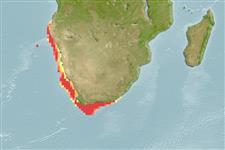Elasmobranchii (Haie und Rochen) (sharks and rays) >
Carcharhiniformes (Ground sharks) >
Scyliorhinidae (Cat sharks) > Scyliorhininae
Etymology: Scyliorhinus: skylion, Greek for dogfish or small shark; rhinus, from rhine (Gr.), rasp, alluding to a shark’s jagged, rasp-like skin (See ETYFish); capensis: -ensis, Latin suffix denoting place: Cape of Good Hope, South Africa, type locality (See ETYFish).
More on authors: Müller & Henle.
Environment: milieu / climate zone / Tiefenbereich / distribution range
Ökologie
seewasser demersal; tiefenbereich 26 - 495 m (Ref. 5578). Subtropical; 0°S - 37°S, 0°W - 29°E (Ref. 57015)
Southeast Atlantic: Lüderitz, Namibia to central Natal, South Africa.
Length at first maturity / Size / Gewicht / Alter
Geschlechtsreife: Lm 69.0, range 68 - 70 cm
Max length : 122 cm TL Männchen/unbestimmt; (Ref. 244)
Kurzbeschreibung
Bestimmungsschlüssel | Morphologie | Morphometrie
Rückenflossenstacheln (insgesamt) : 0; Afterflossenstacheln: 0. Bright yellow or golden spots on a dark grey body with irregular blotches and saddles (Ref. 5578), cream below (Ref. 5510); 2nd dorsal much smaller than 1st (Ref. 5578). Small anterior nasal flaps that do not reach mouth, no nasoral grooves (Ref. 244).
Body shape (shape guide): elongated; Cross section: compressed.
A common inshore to offshore catshark. Prefers to feed on small bony fishes and crustaceans, also cephalopods (Ref. 244). Oviparous (Ref. 50449).
Oviparous, with a single egg per oviduct at a time (Ref. 244). Oviparous, paired eggs are laid. Embryos feed solely on yolk (Ref. 50449). Size upon hatching below 31 cm (size of young with umbilical scars) (Ref. 244).
Compagno, L.J.V., 1984. FAO Species Catalogue. Vol. 4. Sharks of the world. An annotated and illustrated catalogue of shark species known to date. Part 2 - Carcharhiniformes. FAO Fish. Synop. 125(4/2):251-655. Rome: FAO. (Ref. 244)
IUCN Rote Liste Status (Ref. 130435: Version 2025-1)
Bedrohung für Menschen
Harmless
Nutzung durch Menschen
Fischereien: nicht kommerziell; Sportfisch: ja
Tools
Zusatzinformationen
Download XML
Internet Quellen
Estimates based on models
Preferred temperature (Ref.
123201): 9.3 - 16.5, mean 12.2 °C (based on 45 cells).
Phylogenetic diversity index (Ref.
82804): PD
50 = 0.5000 [Uniqueness, from 0.5 = low to 2.0 = high].
Bayesian length-weight: a=0.00263 (0.00138 - 0.00502), b=3.21 (3.04 - 3.38), in cm total length, based on LWR estimates for this (Sub)family-body shape (Ref.
93245).
Trophic level (Ref.
69278): 4.0 ±0.5 se; based on diet studies.
Widerstandsfähigkeit (Ref.
120179): sehr niedrig, Verdopplung der Population dauert mehr als 14 Jahre. (Fec = 1).
Fishing Vulnerability (Ref.
59153): High to very high vulnerability (73 of 100).
🛈
